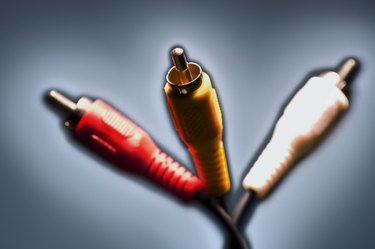
RCA cables have been in existence since the early 1940s, connecting Victrola turntables to radio systems. Since then, the cabling type has expanded into multichannel surround sound, video and digital audio applications. Although the cable's essential construction varies little when used with these signal types, limitations of the types change how far you can run an RCA cable before encountering signal degradation.
Standard Audio
Video of the Day
Stereo audio is the standard use for most RCA cables. The issue with a well-shielded cable has to do with signal output voltage. Every preamplifier or receiver, whether home or car, outputs a certain level of audio signal, measured in volts. Most preamp outputs are 1 to 2 volts, while higher-end outputs measure from 4 to 14 volts. Higher voltages are commonly used in car audio applications to counter noise. However, resistance on the cable means that you are limited as to how far you can run the cable before losing significant voltage along the way and perhaps encountering hum and other undesirable effects. Most RCA audio cables that are built reasonably well with shielding can be run effectively from 100 to 200 feet.
Video of the Day
Component Video
RCA cables are found in clusters of three when used in a component video configuration. Each cable carries one of the red, blue and green components of the video signal. Here again, runs in the 200-foot range are common. However, unlike standard analog audio, impedance becomes an issue. A proper video cable is built to 75-ohm impedance, matching the output of the video device. This impedance prevents the cable from altering the video signal to a significant degree. In cases of long runs, it is important that the cable exhibit a deviation from this 75-ohm standard no more that 1 to 2 ohms total. Any more and shifting colors along with unequal color intensity may be exhibited.
Digital Audio
RCAs used for digital audio are built the same and have the same parameters as component video cables. In this case as well, 75-ohm impedance is required for proper operation. Digital audio sent over RCA cables is robust, provided the impedance does not alter significantly. If it does, periodic drops in audio occur, due to too much data loss that cannot be recovered by the receiving device. Very often, RG-6 coaxial cable with RCA ends is used for long digital coaxial runs, given the extremely high bandwidth capability of this cabling type.
Shielding and Construction
RCA cables must be well shielded. This is true regardless of the application. In addition to resistance on the cable itself, electromagnetic and radio frequency interference may inject itself into the signal without the presence of shielding to block this. As the cabling becomes longer, these factors are increasingly important. Common shield types are foil and braided copper or aluminum, with the most effective being alternating foil and braid configurations. Foil shielding works best against electromagnetic interference, while the braid handles radio frequency intrusion.